Jaguar fangs have become one of the sought-after goods in the Chinese wildlife market, posing a severe threat to Bolivian jaguars. Birds, monkeys, and turtles are also frequent victims of the trade.
By Miriam Telma Jemio
(Photo: Charlesjsharp/Wikimedia Commons)
Bolivia introduced a general and indefinite ban on the wildlife trade two decades ago, but this measure has failed to stop the trafficking of wild animals. Birds, monkeys, turtles, and reptiles that are in high demand as pets remain particularly vulnerable to wildlife crime. In recent years, jaguars have also become victims of the eccentricities of foreign collectors, especially consumers in Asia looking to use animal body parts to cure diseases.
The most serious of these recent trends in trafficking is the illegal trade in jaguar fangs for the Chinese market. Between 2014 and 2016, 337 fangs were seized. Authorities estimate that at least 87 cats were killed in two areas alone: Madidi National Park and the Pilón Lajas Biosphere Reserve and Communal Lands, both in the northern department of La Paz.
Criminal prosecutions have been launched for these crimes. There are also two ongoing cases relating to vicuna hunting in Uyuni and Sica Sica, says Teresa Pérez Chávez, general director of the Biodiversity and Protected Areas Department.
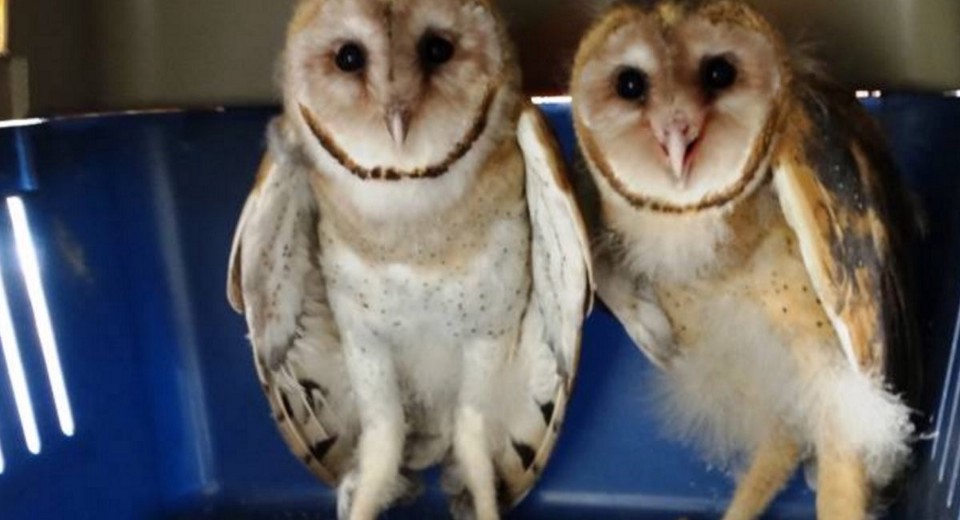
Two confiscated barn owls. (Photo: Courtesy of Santa Cruz)
The illegal sale of both live animals and their body parts in fairs and markets is regularly monitored by the Forestry Police and Environment Protection (Pofoma) along with some regional governments and municipalities. They also monitor trafficking routes and the use of wildlife in folk parades. Seizures of live and stuffed animals are ongoing, and public and private care centers host animals that have been confiscated or handed over voluntarily.
According to the ministry of environment, illegal wildlife trafficking leads to thousands of individuals from dozens of species of both flora and fauna being removed from their habitats. There is no exact data on the volume of animals captured, transported, and traded; according to estimates, only one out of every eight-to-10 animals survives to be sold as a pet.
Bolivia’s minister of environment and water, Alexandra Moreira, said that crimes against wildlife are one of the world’s most influential illicit activities, after the illegal trade of drugs, arms, and human trafficking.
The Illegal Trade of Jaguar Fangs
An operation conducted in May by Pofoma and park rangers in the protected areas of Madidi and Pilón Lajas found a Chinese citizen, Jian Fang Xiao, in possession of seven jaguar fangs. In December of 2014, his compatriot Yan Yixing was caught in possession of 300 fangs, snake skins, deer antlers, and two stuffed feline heads.
To date, Jian Fang Xiao is in preventive detention in a small prison in Rurrenabaque for the crime of “destruction and/or deterioration of state property and national wealth.” Meanwhile, Yan Yixing is under house arrest.
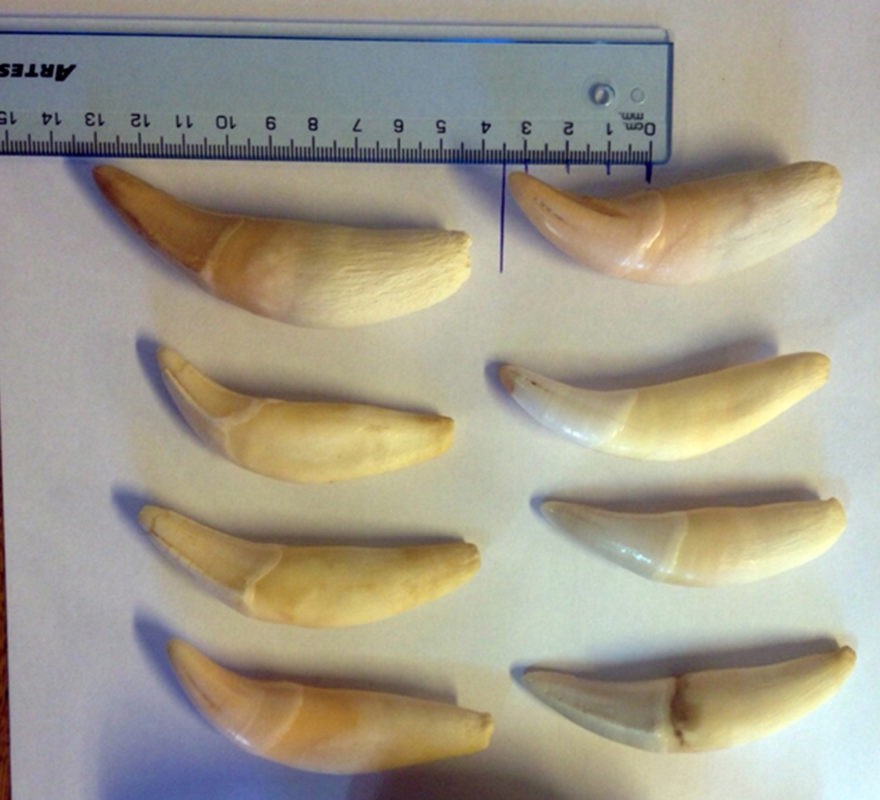
Seized jaguar fangs. (Photo: Courtesy of Pofoma)
These two cases are just snapshots of the vast illicit business of wildlife trafficking. The ministry of environment and water is pursuing a dozen similar cases against Asian citizens, according to officials of the National Service of Natural Protected Areas (SERNANP).
The rise in wildlife trafficking in northern La Paz and western Beni coincides with the development of projects implemented by Chinese companies. “With the presence of Chinese companies in Bolivia, not only is the crime of wildlife trafficking increasing, but also other crimes such as prostitution and human trafficking, due to the number of Chinese workers coming to these companies,” says Daniel Manzaneda, coordinator of the Bolivian Forum on the Environment and Development (Fobomade).
“In Bolivia, we have to start worrying about protecting wild cats such as jaguars, pumas, ocelots, and other wild cats, and implement drastic measures to stop traffic to Asia,” warned Manzaneda in a Fobomade publication.
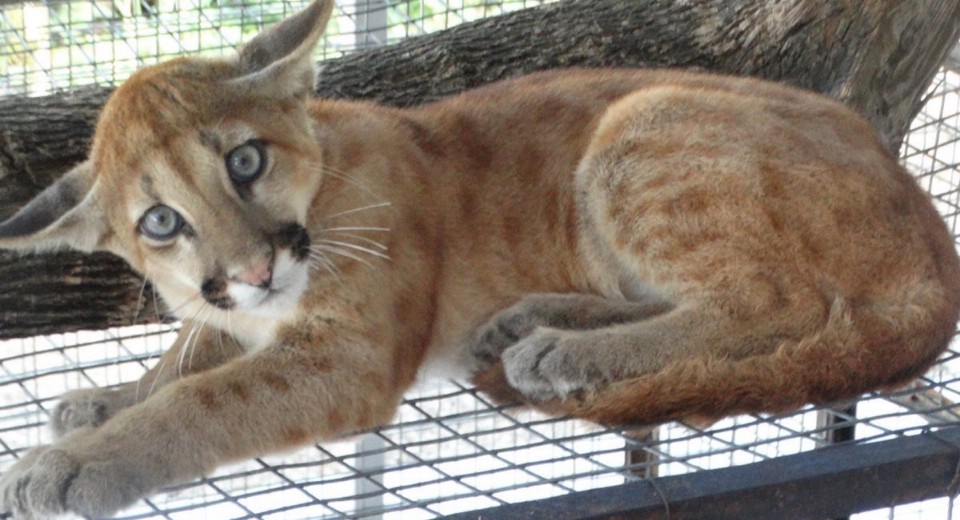
A rescued puma cub, one of the felines threatened by wildlife trafficking. (Photo: Courtesy of Santa Cruz)
The jaguar is listed as vulnerable. In other words, it faces a moderate risk of extinction or long-term population deterioration. Until 2009, according to the Red Book of Wild Vertebrates of Bolivia, its biggest threat was habitat loss and, to a lesser extent, the use of its skin in folk dancing costumes. Since 2014, people began hunting jaguars to extract their fangs and sell them to the Chinese market.
Between August of 2014 and 2016, 15 shipments bound for China from the departments of Santa Cruz and Cochabamba were intercepted by joint efforts of various institutions responsible for monitoring and controlling illicit activities against wildlife, mainly Ecobol — a Bolivian mail service — and Pofoma. These shipments contained about 337 jaguar fangs. Out of the 15 shipments, two were managed by Bolivians and the remaining 13 by Chinese residents in Bolivia.
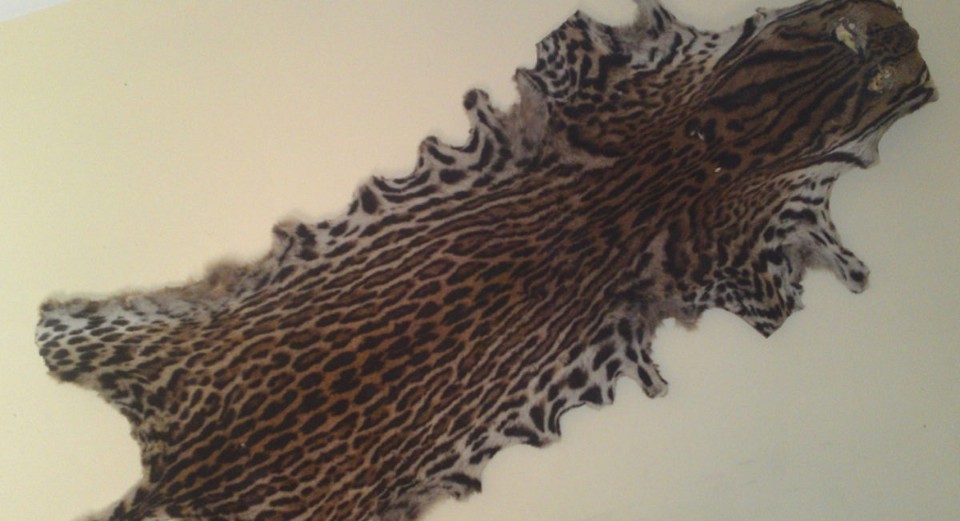
Seized ocelot skin. It was used to make folk dance costumes. (Photo: Courtesy of Pofoma)
“We have an estimate of about 85 dead jaguars. … While, to date, some criminal proceedings have been initiated against people who made the deliveries, none of these proceedings have concluded,” SERNANP noted.
There are also open legal proceedings against the owners of radio stations that broadcast advertisements offering between $100 and $150 for jaguar fangs. This type of offense is categorized as “instigation of crime” because it is a way of inciting people to hunt jaguars.
In March of last year, park rangers in Pilón Lajas Biosphere Reserve and Communal Lands intercepted a 73-year-old Korean citizen who allegedly offered money for jaguar canines. After a hearing in the municipality of San Borja, the judge dismissed the case for lack of evidence and due to the advanced age of the accused.
Commonly Trafficked Species
According to the record of confiscations maintained by the Directorate General of Biodiversity and Protected Areas (DGBAP in Spanish), in terms of the number of individual animals, the most-trafficked wildlife species in Bolivia are lizards and the yellow-spotted river turtle, followed by various species of parrots. When it comes to the number of cases, parrots and armadillos lead this group. According to the DGBAP database, more than 120 species of wildlife were trafficked between 2008 and 2011.
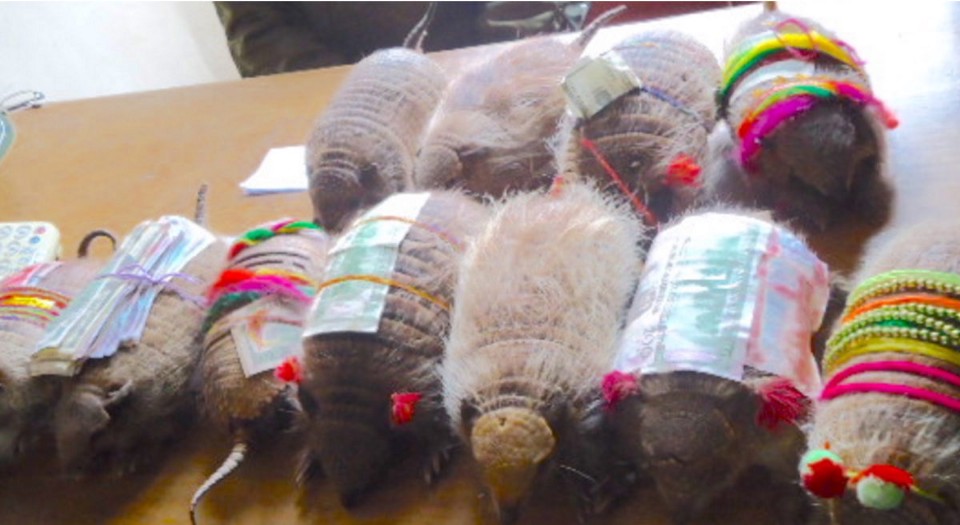
Stuffed armadillos. (Photo: Courtesy of Pofoma)
In Santa Cruz, parrots, monkeys ,and turtles are the animals most affected by the illegal trade. “Unfortunately, in seizures they found species listed as threatened, which currently have very small populations, on the verge of extinction; this is the case for the red-fronted macaw, the giant armadillo, and several cats — margays, ocelots, jaguars, and pumas,” says Yandery Kempff, director of Natural Resources of the Santa Cruz government.
After habitat destruction, the capture of wildlife is considered to be either the second- or third-greatest threat to the survival of many wild bird species, according to a 2008 investigation by biologists Mauricio Herrera and Oswaldo Maillard, members of the Asociación Civil Armonía — a Bolivian non-profit organization dedicated to the conservation of birds and their natural habitats.
Now, due to the overexploitation of bird populations, some of them are vulnerable to extinction. This is the case for the blue-throated macaw, red-fronted macaw, and hyacinth macaw.
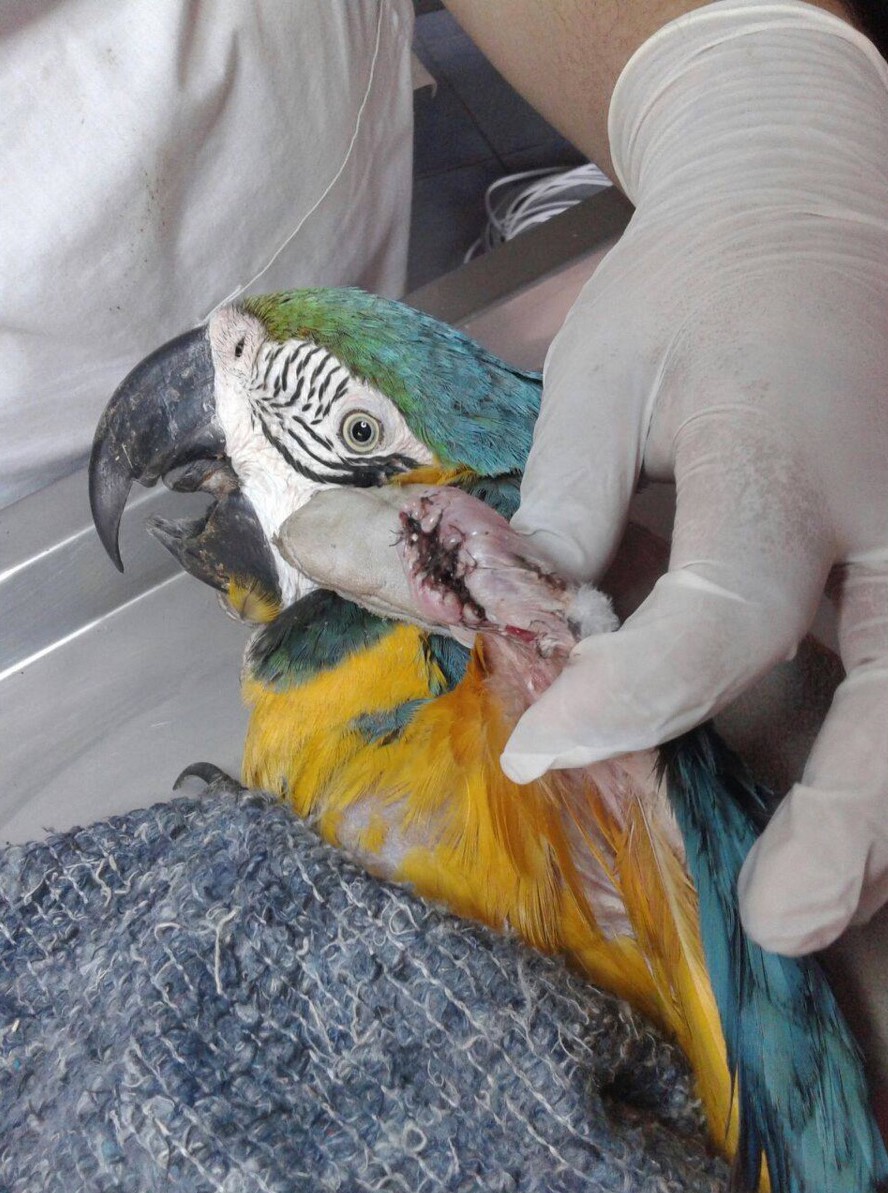
A wounded blue-throated macaw that was rescued by the government of Santa Cruz. (Photo: Courtesy of Santa Cruz)
Studies have found that, due to the methods of capture employed by traffickers and poor transportation and storage conditions, about half of the birds die before being sold; it is estimated that nine out of 10 survivors die before reaching their final destination. Due to these high mortality rates, a large amount of specimens is required to meet demand.
Herrera’s report notes that about 25 percent of the more than 1,400 species of birds recorded in Bolivia have some form of commercial value, including more than 200 that are sold as pets. Trade centers are located in the cities of Santa Cruz, Cochabamba, and El Alto.
The most popular parrot species are the blue-fronted amazon, the monk parakeet, and the blue-winged parrotlet. The species with the highest monetary value is the hyacinth macaw, for which customers can pay more than $1,000; followed by the mealy parrot and the red-and-green macaw, which can fetch $100 each.
While cheaper species are sold in the domestic market, blue-throated and red-fronted macaws are the most threatened and high-value birds. They are often sold internationally via intermediaries. The red-and-green macaw is one of the species most requested by households in Santa Cruz due to its great beauty and ability to mimic the human voice.
The Andean hairy armadillo is the armadillo species most threatened by trafficking. It is listed as endangered because it is subject to heavy hunting pressure for cultural and handicraft purposes. Their body parts are used for the construction of matracas and charangos (percussion instruments), as well as amulets and souvenirs. This use is more restricted and controlled, at least locally, in the city of Oruro, where it has been reduced in recent years due to the implementation of laws. However, they are still sought after for some rituals, such as the feast of the Virgin of Urkupiña, according to Erick Salgueiro, Pofoma’s national chief of operations.
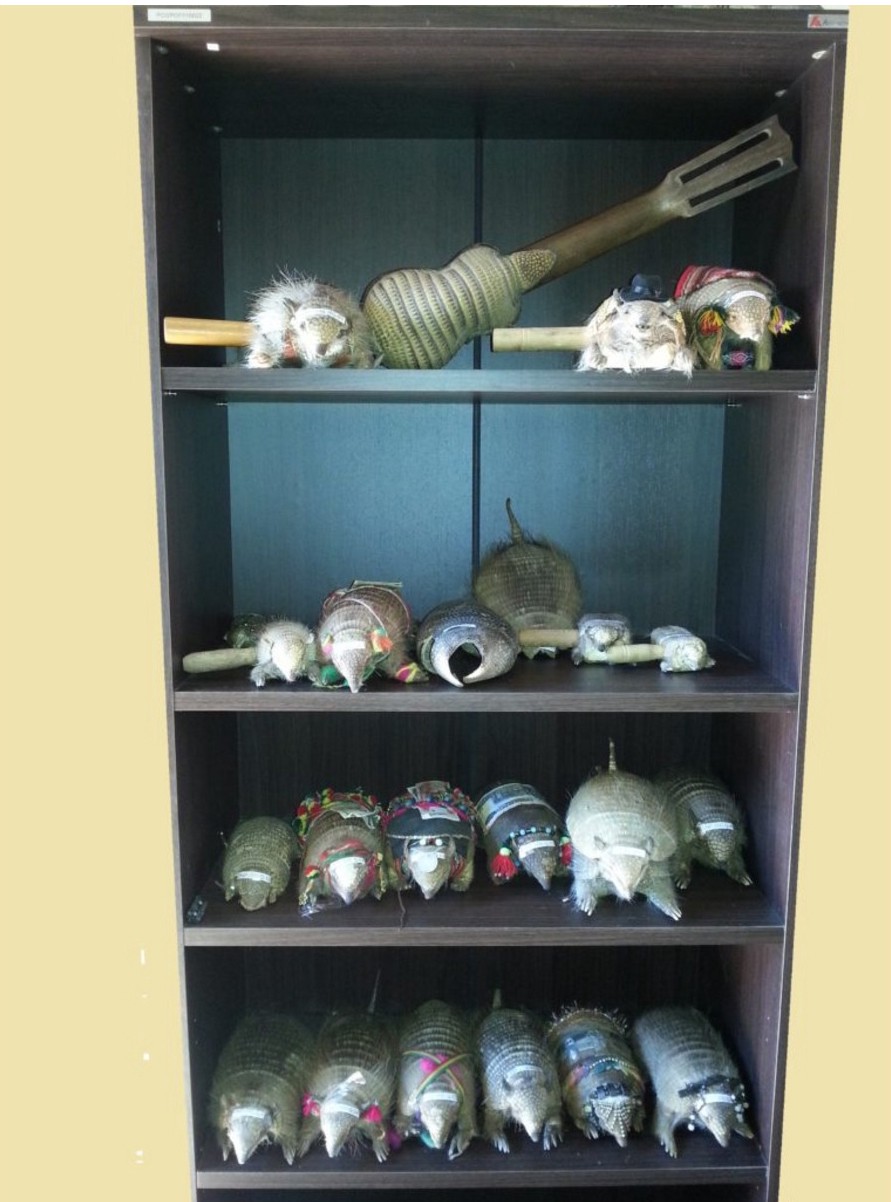
The Andean hairy armadillo is the armadillo species most threatened by illegal trafficking. (Photo: Courtesy of Pofoma)
Bats and lizards are among the animals most commonly used by traditional healers to treat diseases such as epilepsy. A 2008 study by biologist Dennis Lizarro revealed that at least 3,000 animals were sold every two months at fairs in five Bolivian cities. The most frequently traded species (living and dried) are frugivorous, insectivorous, and the common vampire “bloodsucker” bat, which is a rabies carrier.
Luis Fernando Aguirre, coordinator of the Bolivian Bat Conservation Program, says his organization has observed a slight decrease in trade in the main sales centers in Cochabamba (one of the leading wildlife markets, along with La Paz and Santa Cruz). “It’s probably due to the increase of information and awareness campaigns during recent years. But it is not a significant decrease,” Aguirre says.
Healers use live bats so patients with epilepsy can drink the bat’s blood when they cut its neck. Their use by healers and the reduction of their habitat have led 12 species to be listed as either vulnerable or endangered by the International Union for Conservation of Nature.
Monkeys are another of the most frequently confiscated animals and are generally found in private homes as pets. Capuchin monkeys are highly prized for their charismatic nature and intelligence but are often abandoned when they become aggressive.
Young turtles (aquatic and terrestrial) are sold as pets. Hunting and egg collection also threaten the yellow-spotted river turtle.
Main Trafficking Routes
The key selling points used by criminals are distributed throughout Bolivia: markets, fairs, borders, folk parades, exhibitions, tourist attractions, souvenir shops, protected areas, pet stores, aquariums, bus terminals, and airports, among others.
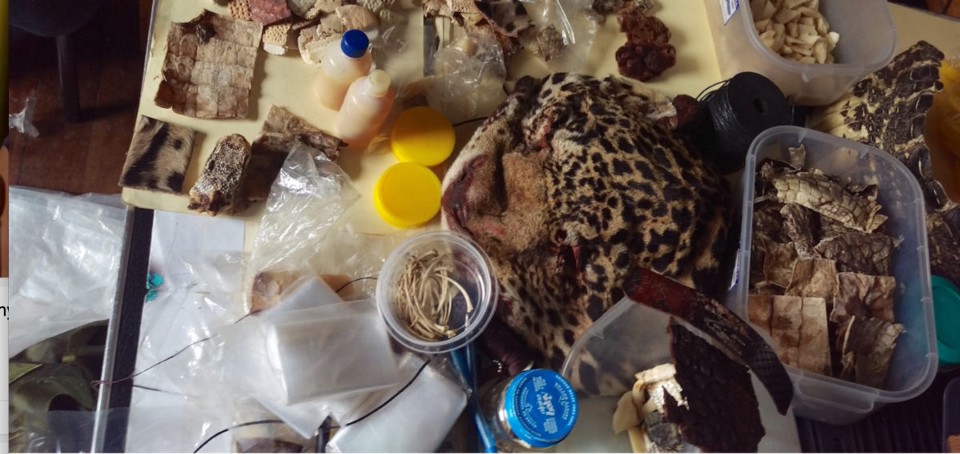
Seized animal body parts such as skins and fangs. (Photo: Courtesy of Pofoma)
Traffickers transport lizard skins, alligators, iguanas, or other species of living animals and plants in the cargo compartments of trucks and buses. Travelers’ luggage is used to smuggle small items like handicrafts made from animal body parts, stuffed lizards, bird and turtle eggs, and live animals like hummingbirds, parrots, and butterfly pupae.
Dead butterflies and beetles, and their body parts, are often shipped abroad to private collectors by regular mail.
A Declared War
Until four years ago, employees of the Bolivian mail service company (Ecobol in Spanish) and the National Customs had not been trained to identify animals and animal parts banned from trade, says Miguel Molina, the DGBAP monitoring coordinator. Now, with the development of these skills, both institutions work in the fight against wildlife crime.
In five years, Ecobol reported at least 10 cases of wildlife trafficking in the form of live or stuffed animals, body parts or derivatives such as skins, shells, and musical instruments, which were being exported to destinations including Europe and Asia. According to the ministry of environment, the species found were the dwarf armadillo (shells, stuffed or in charangos), butterflies (mounted in display cases), lizards (desiccated), turtles (shells), beetles in cardboard boxes, live ants, and jaguar skin camouflaged in garments.
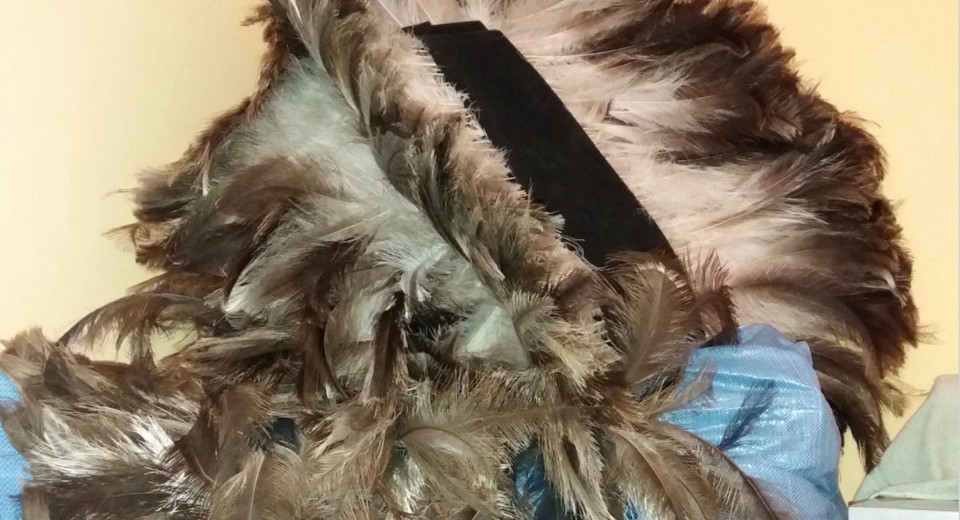
A seized headdress made of ostrich feathers. (Photo: Miriam Telma Jemio)
Salgueiro, Pofoma’s national chief of operations, says the number of live wild animals offered at the July 16th fair in El Alto — a place with a high concentration of illicit activity in the department of La Paz — has reduced in recent years. Now, stuffed lizards and toads, species that started being seized a couple of years ago, can only be found in places like the Alasita fair, where they are sold as amulets to attract good fortune.
Until a decade ago, it was a common practice for dance groups to use materials derived from wildlife in their costumes. The Suris Sicuris wore ostrich feathers; condor costumes were made with natural feathers and dwarf armadillo shells were turned into matracas. In 2008, the ministry of environment, the Association of Folkloric Groups of the Great Power of La Paz, and the association of embroiderers signed an agreement that progressively eliminated the use of animal body parts in costumes. In 2012, the University Entrance (traditional parade where university students perform typical Bolivian dances) almost completely stopped using animal body parts in their wardrobe. Today, they only use synthetic materials in their garments; this is also the case for dance groups involved in the Carnival of Oruro and the Virgin of Urkupiña parades, according to Salgueiro.
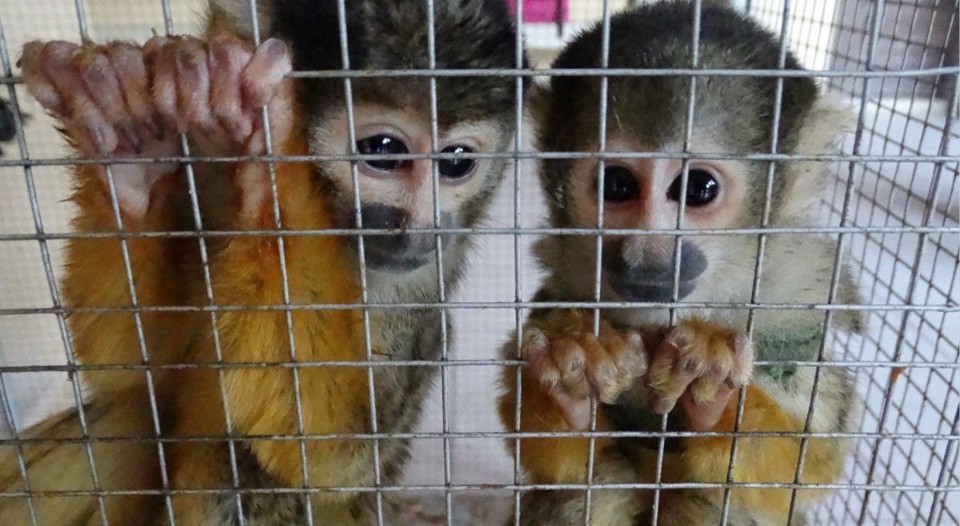
Squirrel monkey rescued by personnel of the government of Santa Cruz. (Photo: Courtesy of Santa Cruz)
Local governments are also committed to inspection activities, particularly those of La Paz, Cochabamba, and Santa Cruz. In the case of the latter, within three years of the implementation of a biodiversity program, the trafficking and illegal possession of 8,000 wild animals was avoided. Most of the rescued animals were returned to their natural habitats, while others were transferred to rescue centers. In addition, Yandery Kempff says that they conduct awareness campaigns that have already reached more than 900,000 people.
“More than 90 percent of the animals entering the trafficking chain are sold directly on the local market and also through social networks. Species considered rare, charismatic, or threatened are the ones that traffickers choose to capture and sell abroad,” says the director of natural resources of the Santa Cruz government. There are 20 ongoing criminal proceedings for this topic.
“We believe it is our achievement that people now know that having a wild animal as a pet is illegal, so much so that we receive about 100 calls a month about reports on this issue,” she says.
Care Centers
Hundreds of wild animals are welcomed temporarily or permanently in the 22 care centers located across Bolivia. These animals are handed over voluntarily or arrive after being seized by the Pofoma or abandoned.
One of these centers is Senda Verde, located in the Yungas of La Paz, which currently houses 650 animals. “To reach that number, about 6,000 died. That is to say, one out of 10 animals survived. Behind every case, there is a sad story. One case that touched the hearts of most Bolivians was the story of Ajayu the bear, who was brutally beaten in Cochabamba and became blind as a result. After six months of care, Ajayu recovered physically and emotionally,” says Vicky Ossio, the director of that institution.
The Municipal Vesty Pakos Zoo of La Paz is home to 562 animals from 82 species, of which more than 500 were rescued and the rest born in captivity; 99 percent of this group were victims of abuse. The animals were seized from traders and rescued from houses and circuses in Cochabamba, Oruro, Potosi, Yungas, Riberalta, and El Alto.
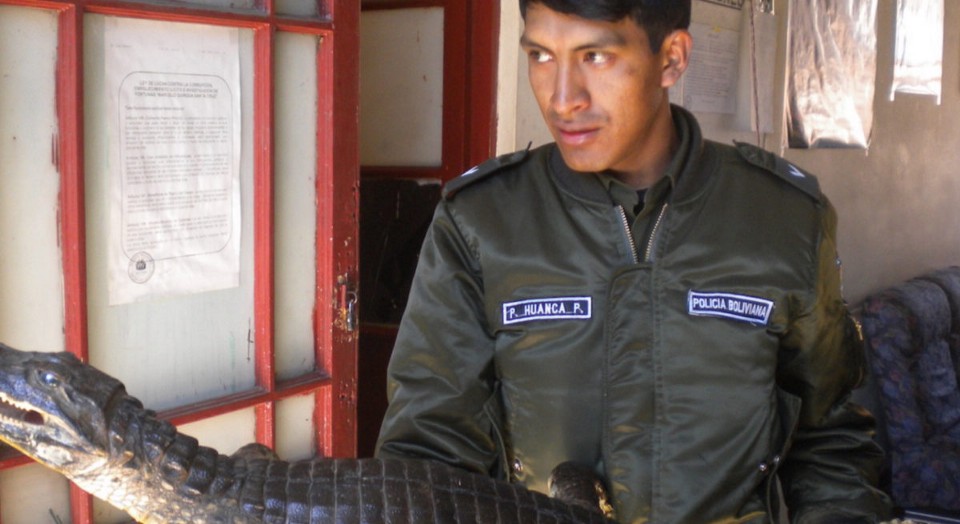
Police show a seized caiman. (Photo: Courtesy of Pofoma)
In 2015, they accepted about 100 new animals. The zoo spends around 2.5 million bolivianos ($359,975) on food and medicine alone. A lion eats 4.5 kilos of meat a day, a jaguar 3.5 kilos, and a puma 2.5 to 3 kilos. “We have stopped accepting animals this year because we have a budget and a food schedule that does not allow us to welcome even one more animal,” says Andrea Morales, manager of the zoo.
Each week, turtles, parrots, monkeys, and badgers (the animals most commonly traded for pets) arrive at the center due to illegal possession. Morales says she has not noticed any reduction in the influx of confiscated or rescued animals, but she hopes the campaign undertaken by the central government will result in a decrease in animal trafficking. “It is not about building more care centers. It is about preventing the capture of more species from their habitats because of the demand for pets,” she says.
Bolivia: ‘Fierce for Life’
The illicit trade in wildlife has increased in recent years despite the joint efforts of the international community, governments, and civil society. So, the United Nations launched the global campaign “Fierce for Life.”
Adopting the slogan “They have no voice, we do. Fight against illegal trafficking of wild animals,” Bolivia joined the campaign on April 22nd. “The campaign is focused on raising awareness that wild animals are not pets, they should be in their habitats because they play a vital role in the ecological balance. Regulations on the subject are also being communicated,” says Teresa Pérez, the director of the Bolivian Biodiversity and Protected Areas Directorate.
This story originally appeared at the website of global conservation news service Mongabay.com. Get updates on their stories delivered to your inbox, or follow @Mongabay on Facebook, Instagram, or Twitter.





